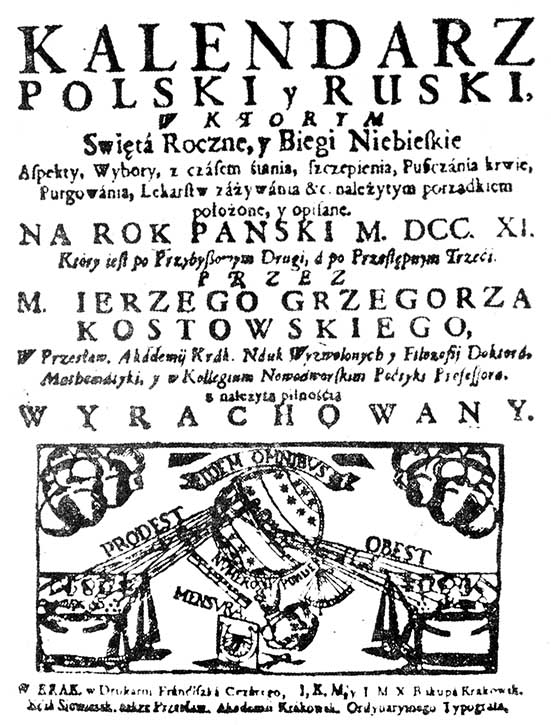Od Sasa do Stasia – Kalendarze
W XVIII w. zaczęły ukazywać się kalendarze polityczne, obywatelskie, ekonomiczne, gospodarskie, przemysłowe, sejmowe, „krajowe i zagraniczne”, teatralne, dla „prześwietnych dam”, a nawet dla… kochanków. Poziom ich był różny.
Kalendarze dzieliły los polskiej kultury, były zarazem jej odbiciem. Były więc kalendarze „saskie” i „oświeceniowe”. Oczywiście, trudno wyznaczać jakieś sztywne linie podziału, zwłaszcza w 1 połowie XVIII w. Nurt „saski” w kulturze toczył się przecież jeszcze w czasach Oświecenia, nurt zaś „oświeceniowy” wyprzedził na wiele lat „epokę stanisławowską”. Przykładem tego — najbardziej znany, bijący rekordy poczytności, ukazujący się ponad setkę lat w licznych redakcjach i edycjach — „Kalendarz polski i ruski”, w którym „święta roczne i biegi niebieskie, aspekty, wybory, czas siania, szczepienia, krwie puszczania, lekarstw zażywania, wschód i zachód codzienny” zostały opisane i „z należytą pilnością wyrachowane” przez najrozmaitszych „nauk wyzwolonych i filozofii doktorów” oraz „matematyki profesorów” Akademii Krakowskiej lub Zamojskiej.
Tytuł jeden — ale wydawców… co najmniej dwóch. Pierwszym — była Akademia Krakowska. Wydawała ona „Kalendarz polski i ruski” (tzw. „akademicki”) w Drukarni Akademickiej w Krakowie — czasem w kilku wersjach na ten sam rok i w kilku wydaniach. Zawsze jednak pod tym samym tytułem, zawsze w tym samym układzie. Kalendarz na ogół zawierał: prognostyk roczny, kalendarium ze szczegółowym (codziennym, tygodniowym i miesięcznym) aparatem prognostykarskim, artykuły z zakresu gospodarstwa i historii naturalnej, tabelę do nastawiania zegarów, wiadomości o jarmarkach, wierszyk moralizujący, ogłoszenia księgarskie itp. Kalendarz ten ukazywał się od 1716 do 1780 r. (ale i w dalszych latach — jako opracowania prywatne). Redagowali go profesorowie Akademii Krakowskiej.

Kalendarz cieszył się dobrą opinią. Ukazywały się w nim teksty z ambicjami, a w każdym razie zgodnie z ówczesnym stanem wiedzy o świecie.
I w kalendarzu „akademickim” występowały jednak jeszcze „sekreta rozmaite”, „ciekawości różne”, „rzeczy osobliwe”, a nawet po prostu „cudowności”, tak bardzo charakterystyczne dla kultury epoki saskiej. Ot, choćby takie, jak „właściwości kamieni” w kalendarzu Jakuba F. Niegowieckiego z 1748 r. Uczony ten profesor stwierdzał z powagą, iż… gagatek „w wodę włożony zapala się, olejem zaś skropiony ugaszony bywa”, opal „serce rozwesela i umacnia”, ametyst „szkodliwe wapory z głowy wypędza”, szafir „wrzody, krew z nosa leczy” itp.
Drugim wydawcą „Kalendarza polskiego i ruskiego” był Stanisław z Łazów Duńczewski (1701—1767), „nauk wyzwolonych i filozofii doktor” oraz Akademii Zamojskiej „matematyki profesor”, a następnie dziekan Wydziału Prawa. Niestety, opinii nie miał dobrej. Stawiano go obok… ks. Benedykta Chmielowskiego, autora słynnych „Nowych Aten”. Nie ulega wątpliwości: był spadkobiercą niezbyt dobrej tradycji intelektualnej. Ale też… trafiał idealnie w potrzeby i gusty ówczesnych czytelników. I to przez dziesiątki lat!
Początkowo (od 1725 r.) kalendarz swój wydawał w Krakowie, następnie (począwszy od 1741 aż do swej śmierci) w Zamościu. W dwóch wersjach: „mniejszej” i „większej”. Jego dzieło kontynuował syn, po kilku latach (w 1775) zawiesił jednak działalność. Ale kalendarz istniał nadal i wydawany był przez różnych wydawców i drukarzy jeszcze przez kilka dziesiątków lat XIX w.
„Kalendarz polski i ruski” Duńczewskiego uchodził za obskurancki. I taki chyba był naprawdę. Duńczewski wierzył bowiem w astrologię, jak również w czary i egzorcyzmy, i dawał temu wyraz w swych kalendarzach. Chętnie zamieszczał również przepisy i wskazania lekarskie o charakterze magicznym, horoskopy z gwiazd i planet, objaśnienia różnych „znaków” niebieskich i nieczystych sił, różne „miscellanea” oraz „ciekawości” o świecie, ludziach, zwierzętach itp. Kpiono z tego kalendarza, ale i powszechnie czytano. Była to zresztą często jedyna lektura mas szlacheckich i mieszczaństwa.
Nie wiemy, w jakich nakładach ukazywały się ówczesne kalendarze. Zapewne osiągały nawet po parę tysięcy egzemplarzy. (Wolter skarżył się w 1768 r., iż w Europie sprzedaje się 400 tys. kalendarzy, które „pouczają nas, w jakie dni należy puszczać krew, a w jakie brać na przeczyszczenie”. Ta skarga odnosi się i do wielu polskich kalendarzy.) Wiadomo w każdym razie, że tylko w latach 1750—1800 ukazywało się w Polsce co roku kilkadziesiąt kalendarzy. Małych, skromnych, wydawanych byle jak, i wielkich, opasłych, kolorowych, bogato zdobionych. Ocenia się, że trafiały do co najmniej 100 tysięcy czytelników.
